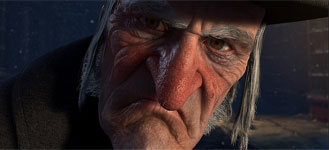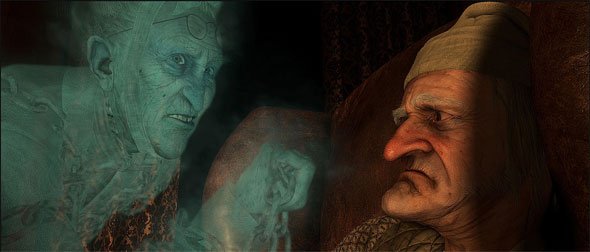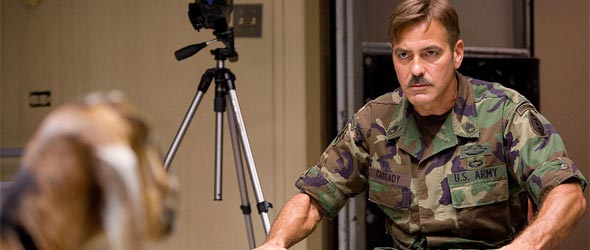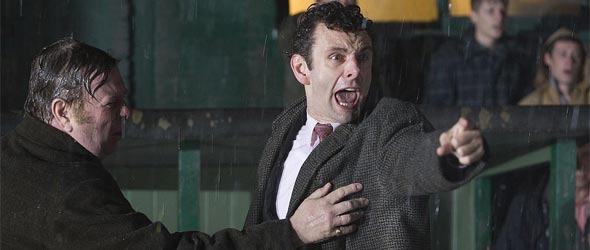Reviews
A Christmas Carol (Disney)

The Stab: Visually spectacular, then some more—to the point of monotony. A scary story more than a Holiday moralistic tale, with emotional resonance suffocated by its showy display.
Stuffed fuller than a Christmas goose, Disney’s animated adaptation of Charles Dickens’ classic tale is overlong, overstated, and overindulgent. We all know the story: the greedy and grouchy Ebenezer Scrooge learns the importance of benevolence while guided by spirits through his past, present, and future.
There are new interpretations to be found here, but I wouldn’t consider them all improvements. Scrooge is constructed on a foundation for his miserly ways. He was ostracized as a child. He hails from an abusive home. The animation efforts along with Jim Carrey’s voice work portray Scrooge not as a villain, but as the broken-down remains of a miserable life. We feel sympathy for Scrooge.
As each ghost (also voiced by and modeled in the likeness of Carrey) arrives to put Scrooge in his place—chasing him down, hurling him through the air, knocking him off his feet—they torture a helpless old man. Scrooge needs psychotherapy—not this Christmas terror.
And what a terror it truly is! A Christmas Carol works best, perhaps, as a pipedream holiday horror film. The ghosts are large, ominous, and disturbingly volatile. Scrooge is opened to a world of desperate, aimless souls, floating in their murky, sickly green outlines. The “Ghost of Christmas Yet to Come” looks more like a resident of Sleepy Hollow: the grim reaper’s shadow coaxing horses from hell.

But these spectral mentors spend much more time bullying Scrooge than teaching him anything. The glimpses they offer into the past, present, and future display the CliffsNotes version of the CliffsNotes version of Scrooge’s circumstance. Events and emotions are simplified and summarized. The time that remains is expended through a crawling pace, visual binges, and camera acrobatics—flyovers, pans, dips, spins, and twirls. (Vestibularly-challenged folks might want to skip this one.)
The artistry is quite stunning, even breathtaking with the added 3D effects, but aesthetic intent overwhelms the narrative. The film invests in mechanics over emotions. When we zoom over the snowy London rooftops for the sixth time, it’s still dizzying—this time in the way that induces vomit. If you take away the trimmings, there might be 15 minutes of story underneath. Stretched over an hour and a half, the film has trouble holding interest.
On Christmas morning, Scrooge hasn’t transformed into a hearty, happy being: he’s rightfully gone insane. Yes, he required a personality overhaul, but surely he wasn’t so wretched that he caused Tiny Tim’s polio. That’s what the puzzle says as the pieces fit together. Somehow, I don’t think that, or much of this film, is the Christmas Carol Disney intended to tell. • C (Rated PG • 96 minutes)
Tickets & Showtimes» Tickets & Showtimes (3D)» Watch the Trailer» Visit the Website»
The Fourth Kind (Universal)

**Adam’s Weekend Pick**
The Stab: An unnerving sci-fi horror film, bolstered by the use of (allegedly) real footage delicately handled by its director.
Do you believe in aliens? If not, you might reconsider after watching The Fourth Kind, a stirring film that weaves together actual footage and dramatic recreations to tell a story of inexplicable truths.
The film opens on star Milla Jovovich directly addressing the camera, informing us that this story is based in truth and warning us of disturbing imagery. It’s the steroid-injected version of the “viewer discretion is advised” notice before a racy television program. Bring it on!
Jovovich plays Dr. Abbey Tyler, a psychologist from Nome, Alaska who struggles to keep her family together—her hysterically-blind daughter and increasingly estranged son—after the death of her husband. Dr. Tyler continues a study she and her husband began that involves treating insomniacs with hypnotherapy. She quickly uncovers stunning similarities between each of her cases. Investigating further, her findings become quite unsettling, pointing toward alien abduction theories.
When she’s required to wear emotion, Milla Jovovich proceeds unsteadily. When she’s poised in the therapist’s seat, she’s fantastic, conducting her sessions with a graceful control. It is here that the film really shines. Hypnosis sessions are rendered boldly and artfully, with split screens crawling in and out of the frame placing recorded footage beside its dramatized counterpart. The simultaneous perspectives avoid redundancy. Dramatic recreations impart a professional polish and fill in the gaps left by the spotty footage.
As for the recordings: they are shocking, disturbing, frightening. Through the static and video tracking, we see levitations and convulsions, hear terror and desperation. Are the videos real? That’s what we’re told, and to enjoy this film, why not take the harmless plunge? Though I do wonder how paranormals manage to muck up our video equipment every time they enter the frame. Intercut throughout the film are clips from a haunting interview with the “real” Abbey Tyler. Her eyes are distinguished flames. Her face bears the weight of desolation. She hasn’t just seen a ghost—she is a ghost. A supremely creepy display.
When dramatics are unassisted by footage, the film is notably less alluring. Director Olatunde Osunsanmi smartly focuses claustrophobically on his actors’ faces, but suspense relies heavily on a thunderous score, overly heated and cheesy exchanges, and wide shots of the Alaskan landscape. Osunsanmi does his best to string together a fragmented story, but enough documented footage could have constructed a fully fascinating paranormal study.
In any case, The Fourth Kind will get you thinking. How do you explain these occurrences? Alien abductions? Something in the water? Or did Dr. Tyler, driven mad by the death of her husband, concoct a conspiracy, exploiting the fragile minds of her sleep-deprived patients to bolster her own delusions? All frightening notions, and the film itself is a frightening experience to be had. • B- (Rated PG-13 • 98 minutes)
The Box (Warner Bros.)

The Stab: A bizarre and confusing thriller. Sometimes farcical, sometimes straight-laced, seldom consistent. Stumbles more than it succeeds.
The premise is immediately simple. One morning, a husband and wife receive a strange package. Inside that package is a box. On that box is a button. A stranger visits and makes them an offer: if they push the button, they receive one million dollars—but someone, somewhere in the world will die.
The couple, played by James Marsden and Cameron Diaz (who looks and sounds like True Blood’s Sookie Stackhouse after a few years of binge drinking and chain smoking), spends a good deal of time forming their decision. But it doesn’t end there: it really just begins.
The plot takes many a convoluted turn toward a comprehensive sci-fi conspiracy. It’s occasionally intriguing but far too often just baffling. The film never fully commits to any cause. It trades its deceptively simple quirk for random, eerie imagery before half-heartedly embracing a science fiction narrative. Between all of the shifts in focus, the film fails to find its voice.
The Box does create a fair amount of anxiety and provides a lot to process, but in the end, much remains unexplained. Meaning is elusive, and applications to our own existence are just as fleeting. The film is odd and interesting enough that it might amass a small supportive base, but underneath the ambiguity, I’m left to wonder, what is the point? • C+ (Rated PG-13 • 115 minutes)
The Men Who Stare at Goats (Overture)

The Stab: Solid performances can’t salvage this poorly-conceived, complacent project. Misguided in purpose and message, with a mostly inane sense of humor.
What do you get when you take a dumb comedy, wrap it in an interesting story, and fill it with talented actors? You get a dumb comedy, plus an overwhelming sense of waste.
Ewan McGregor is Bob Wilton, a reporter who, down on his luck, seeks salvation in the journalistic goldmine of Iraq. Before he can find his story, his story finds him: a mustachioed George Clooney as the screwy army vet Lyn Cassidy. Clooney rightly roots his crazy in subtlety, but there’s a sense he’s barely trying.
Cassidy describes the US army’s attempts to form a “New Earth Army,” troops with psychic abilities and superpowers. The narrative cuts between the supernatural legion’s formation, Cassidy’s auspicious involvements included, and our headlining duo traipsing through the desert, held in captivity by various parties. The idea of psychic soldiers is insane, and indeed, the film faithfully acknowledges that.
Jeff Bridges is in delightfully blithe spirits as Bill Django, the battalion’s founder and leader, but Django’s efforts do not convey a pacifist’s search for wartime alternatives. Instead, he captains a crew of oblivious idealists, demented by their own flower-power.
The distinction might be irrelevant if it weren’t so contextually dangerous: The Men Who Stare at Goats marks the most irresponsible kind of filmmaking. It asserts that some of its historically-substantial narrative is true but fails in its course to distinguish fact from fiction. The story is confounding, and the inventions of poetic license are surely able to pass as reality.
The most nagging question is who in their right mind would approve such a stupefying experiment? Blame is passed between Reagan, Hollywood’s favorite presidential scapegoat, and the devious minds at the Pentagon. Of course, Django and company couldn’t possibly be at fault: their minds are too blank, their wills too pure.
Filmmaking ethics aside, the story often suppresses itself with cheap humor. Rooftop tumbles, scrotal torture, and drug-induced hysteria all feature prominently. The only consistent message conveyed by The Men Who Stare at Goats is that Americans are unfailingly stupid. If the film is greeted with widespread enthusiasm this weekend, they might be right. • C- (Rated R • 93 minutes)
The Damned United (Sony Classics)

The Stab: Far too focused on the details. It’s potentially a faithful rendering of soccer politics (hardcore sports enthusiasts may consider it a miracle), but it neglects its plot and its people.
This compulsive pseudo-sports film inhales statistics and exhales bracketed division placements. Schemes and schematics thrive in the soggy English air—but not much else.
The film analyzes how Brian Clough improbably became manager of the champion Leeds United football club in 1974. (A reminder: “football” in the Isles is played with the feet.) It’s not so much about the ball playing, nor is it really about Clough; The Damned United delves into the damnedest details of the politics behind it all. Success is a string of managerial manipulations, bypassing athletic accomplishments and even the wills of the footballers themselves. The players are not people; they are pawns in a bureaucratic chess match.
Michael Sheen is joyously cheeky and charming as the indefatigable Clough, though his attempts to offer a character study are quashed by the plot’s obsession with calculus. Clough’s decision-making prowess that propelled his Derby County club to the top of the ranks proves interesting, though difficult to track—and the complexity grows wearisome.
Efforts out of the editing room to liven things up yield mixed results. We scroll up and down a ranked list of England’s competing football teams, watching Clough’s contributions ratchet up tallies. This helps procure narrative clarity, but the effect is overused and impersonal. We time travel between Clough’s stint with Leeds United and his previous professional emergence atop the lowly Derby league. This keeps us on our toes but moreso has a tendency to dispel narrative momentum.
When the film runs out of sports-centric story to spin, it swerves focus onto the bond between Clough and his associate Peter Taylor (played at the sidelines by Timothy Spall). Not so fast! The turn is as deceptive as Leeds’ corrupt fielding tactics.
But in the end, even cheaters are irrelevant. According to The Damned United, games are won by smart politics and savvy maneuvers behind-the-scenes. It’s not the most typical movie message, and I’m not sure I buy it either. • C+ (Rated R • 97 minutes)
Coco Before Chanel (Sony Classics)

The Stab: A smartly dressed biopic that offers little we haven’t seen before. Audrey Tatou is strong as usual, but the film is a mundane and superfluous study.
Coco—before Chanel—was a bitter, brazen woman who struggled very little for her eventual success. That’s how this fairly drab though well-groomed biopic depicts its titular topic, despite its own attempts to convey some sense of subjugation.
Coco, born Gabrielle, is forever jaded after being abandoned by her father at a young age. Audrey Tatou wears a stirring soullessness in her gaze and barks, when provoked, at the behest of Coco’s broken spirit. After a stage act with her sister falls through, Coco realizes her quickest ticket to the good life lies beside her lecherous admirer Monsieur Balsan (Benoît Poelvoorde).
When she, the working-class orphaned girl, joins him in Paris, he hides her contrarian demeanor and sharp tongue from his socialite comrades. But it doesn’t take long for Coco to make her presence known—nor does it take much effort. Chanel becomes a quirk in France’s social elite, mostly by the good graces of open-minded acquaintances. Her biggest hurdle is learning to ride a horse. The story doesn’t breed much sympathy.
Despite new beginnings, Coco remains embittered and becomes ungrateful, bending to the wills of not even her sturdiest financial investors. Some narrative velocity is mined from a love triangle (tri-cornered geometric relations appear to be mandatory biopic devices these days) that pins Coco between Balsan and the overly charming Arthur “Boy” Capel (Alessandro Nivola). Coco’s obligations to Balsan promote intrigue, but the tug-of-war grows stale.
Boy makes an emotional connection with Coco and readily encourages her talents. But we see little of her creative process and scarcely gain insight into her design aesthetic. The work we do see is underwhelming—a few black hats, a flat orphan’s robe—though her perspective is admittedly more tasteful than the frills and feathers of the time.
The film concludes with a dazzling display, and the weight of this woman’s work is palpable at last. Then we fade to black. Apparently, there is a much more involving story to tell: the story of Coco after Chanel. • C (Rated PG-13 • 105 minutes)




Leave a Reply
You must be logged in to post a comment.